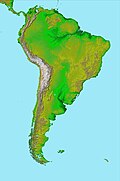Uruguayan dyke swarms
The strike of the dykes has an arcuate pattern: it changes from west to east from NE-SW to E-W and then near the shear zone to NW-SE.
[5] The andesites have higher titanium dioxide contents and are usually darker and more massive, two characteristics that make them more valuable as decorative stone.
Instead, the magma that formed the dykes is thought to be derived from the partial melting of garnet peridotite in a parcel of the Earth's mantle that was metasomatized without the direct influence of subduction.
[4] By the time of intrusion of the Florida dyke swarm, Piedra Alta Terrane was experiencing extensional tectonics.
[7] The Treinta y Tres dyke swarm intrude Brasiliano Cycle granitoids that crop out east of Sierra Ballena Shear Zone.

